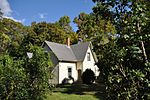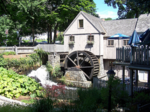Little Pond (Massachusetts)
Plymouth County, Massachusetts geography stubsPonds of MassachusettsPonds of Plymouth, Massachusetts
Little Pond is a 43-acre (170,000 m2) cold-water pond in Plymouth, Massachusetts. The pond is located in Morton Park, adjacent to Billington Sea. The average depth is 19 feet (5.8 m) and the maximum depth is 51 feet (16 m). There are 1.2 miles (1.9 km) of shoreline. Little Pond is a popular summer swimming spot; a public beach runs along the northern shore of the pond. The pond is stocked with rainbow and brown trout.
Excerpt from the Wikipedia article Little Pond (Massachusetts) (License: CC BY-SA 3.0, Authors).Little Pond (Massachusetts)
Burgess Road, Plymouth
Geographical coordinates (GPS) Address Nearby Places Show on map
Geographical coordinates (GPS)
| Latitude | Longitude |
|---|---|
| N 41.941944444444 ° | E -70.686111111111 ° |
Address
Burgess Road 26
02360 Plymouth
Massachusetts, United States
Open on Google Maps




